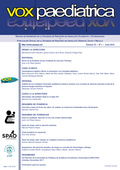![]()
Agenesia renal y anomalías mullerianas a propósito de dos casos
El desarrollo de los conductos mullerianos tiene una relación embriológica estrecha con el del sistema urinario. Esto explica la asociación entre anomalías urinarias y genitales, siendo la más frecuente la agenesia renal. En este artículo presentamos dos casos de Síndrome de Herlyn Werner Wunderlich (SHWW), como otro ejemplo de estas alteraciones.
El SHWW consiste en hemivagina obstruida, útero didelfo y anomalía renal ipsilateral. Sintomatología: dolor, masas pélvicas por obstrucción del sangrado menstrual, hemorragia uterina anormal, amenorrea primaria, hematometra y hematocolpos, abortos o partos prematuros. La resonancia magnética (RM) define el diagnóstico y su detección precoz evita complicaciones.
Es necesario sospechar una alteración mulleriana cuando aparece dolor abdominal y masa despuésde la menarquia y especialmente cuando existan anomalías congénitas del sistema renal.
The development of the müllerian duct tract and the urinary system are closely related during the embryogenesis. This explains the association of anomalies involving both systems, being the renal agenesis the most frequent. Here we report two cases of Herlyn Werner Wunderlich (HWW) syndrome, as another example of these anomalies.
HWW syndrome is characterized by obstructed hemi-vagina, uterus didelphys and ipsilateral renal agenesis. The female patients have dysmenorrhea and irregular bleeding pattern, even primary amenorrhea, and present with pelvic pain, development of masses due to collections of blood in the pelvis, haematometra and haematocolpos, complicated with premature births and/or miscarriage. The diagnosis is established with magnetic resonance imaging (MRI), and prompt identification prevents complications.
It is necessary to exclude these anomalies whenever a female presents with lower abdominal pain and a mass after menarche, especially when there are known malformations of the renal system.
| Adjunto | Tamaño |
|---|---|
| vox_paediatrica_2-2016_web.48-51.pdf | 560.52 KB |



